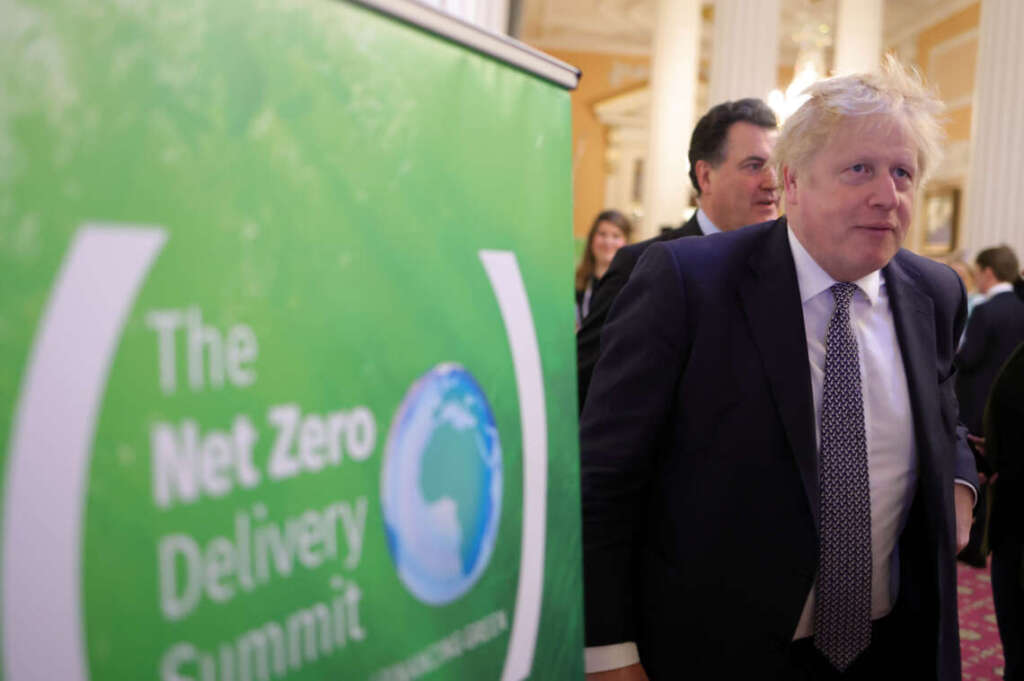Achieving net zero is not just a technological but also a political and cultural undertaking, writes Hasil Farooque
In 2019, the United Kingdom officially committed itself to eradicate all greenhouse gas emissions within three decades, making it the first G7 nation to do so by 2050. This move established one of the most ambitious carbon reduction plans in the world and established the UK as a global leader in climate action.
What is Net Zero? How does a nation achieve it? To put it simply, the UK must balance its total emissions of greenhouse gases (GHGs) with its total removals from the atmosphere in order to achieve Net Zero. Reforestation, carbon capture and storage (CCS), clean energy technology, and emissions reduction can all be used to accomplish this. The ultimate objective is to restrict temperature rise in accordance with the Paris Agreement and stop the UK’s contribution to global warming.
Beyond its effects on the environment, the UK’s Net Zero policy is significant. This is a once-in-a-generation change that impacts industry, transportation, housing, energy, and agriculture. Reaching this goal will change the UK economy, lead to the creation of green jobs, and have an impact on everything from how we commute and consume to how we heat our homes.

Policy Framework: The UK’s Net Zero Strategy
The legal underpinnings of the UK’s net zero policy are among the strongest in the world. The Climate Change Act of 2008, which was passed under Labour Prime Minister Gordon Brown, marked the beginning of that framework. The UK became the first nation to formally commit to carbon budgets when then-Environment Secretary Ed Miliband played a key role in advancing the legislation through Parliament.Climate Change Committee (CCC),a separate legislative body was also established under the act with the responsibility of keeping an eye on developments and advising governments on how to achieve their climate targets.
Ten years later, in 2019, outgoing Conservative Prime Minister Theresa May made history by revising the Act to include a legally binding net zero aim by 2050, making the UK the first country in the G7 to do so. The decision received widespread support from people of all political persuasions and was hailed globally as a daring declaration of intent. By raising the standard from the previous 80% reduction objective, it brought UK law into line with climate science’s recommendations to limit global warming to 1.5°C.
The Net Zero Strategy: Build Back Greener, released in October 2021 under Boris Johnson, gave a comprehensive plan to achieve this objective. The strategy, which was framed as a roadmap for decarbonization and economic renewal, sought to satisfy the UK’s Sixth Carbon Budget, which mandates that emissions be reduced by 78% by 2035. It outlined policies for each of the main economic sectors. The plan pledged to expand offshore wind, nuclear, and solar power in order to power a completely decarbonized electrical system by 2035. It promised to increase charging infrastructure and low-emission aviation while limiting the sale of new gasoline and diesel vehicles by 2030. By 2028, it is aimed to phase out new gas boilers and install 600,000 heat pumps annually for houses and buildings. Carbon capture and storage technology and hydrogen fuel would be used to decarbonise industry, while changes to farming subsidies were intended to promote peatland restoration, tree planting, and more sustainable land use.
Although the strategy outlined goals in grand terms, the CCC has cautioned time and again that the money is unknown, the dates are ambitious, and the details are frequently sparse. In 2023, Lord Deben, its then-chair, chastised the government for establishing goals without sufficient means of achieving them. Without greater responsibility and more consistent investment, the UK runs the risk of not living up to the promises that made it a climate leader in the first place.

Key Challenges and Setbacks
The UK’s net zero transition is having difficulty turning from chat to reality, despite legislative milestones and widespread praise. One of the most persistent weaknesses lies in decarbonising buildings. Slow progress is still being made in two crucial areas for achieving net zero, insulation and heating. The government’s goal of installing 600,000 heat pumps annually by 2028 appears to be getting farther and farther out of reach. Less than 60,000 were fitted in 2023. Uncertain incentives, high upfront costs, and a shortage of installers have kept UK homes from abandoning gas boilers. Millions of homes in the UK are still ill-equipped for the transition and have poor insulation, making it one of the least energy-efficient housing in Europe.
Another significant emitter is transport. Climate activists applauded Boris Johnson’s 2020 announcement that new petrol and diesel vehicles would be prohibited starting in 2030. However, Prime Minister Rishi Sunak postponed that deadline until 2035 in 2023, citing affordability and consumer readiness. The Low Sales of EVs are affecting the implementation of EV infrastructure, and there are notable geographical differences in access to charging stations. The shift now risks stalling at the very moment when momentum was starting to build.
Policy reversals and conflicting government signals make the problem worse. Sunak argued for “pragmatism” in reaching net zero when he confirmed additional oil and gas licenses in the North Sea and postponed a planned ban on new gas boilers. Business executives, scientists, and even former Conservative ministers expressed worry about the announcements, stating that the UK risked investors’ trust in green businesses.
Additional pressure has been added by legal challenges. The High Court concluded in a historic decision in 2022 that the government’s initial Net Zero Strategy was insufficiently specific and unreliable to demonstrate how carbon budgets would be truly fulfilled. In the meantime, there is a strong pushback against policies like London’s Ultra Low Emission Zone (ULEZ), Low Traffic Neighbourhoods (LTNs), and changes to rural land use. These conflicts collectively reveal a more general reality, achieving net zero is not just a technological but also a political and cultural undertaking.
Economic and Political Landscape
Political disagreement and economic distress are the backdrops against which the net zero movement is developing. For already overburdened households, the continuous cost of living crisis caused by high energy prices and inflation has made promoting climate policy more difficult. Even with government subsidies, many people still find the upfront expenses of greener technologies, like heat pumps, electric cars, or house insulation to be expensive.
The problem has grown more controversial on a political level. The previous Conservative government, led by Prime Minister Rishi Sunak, took a more measured, incremental approach, allowing additional oil and gas licenses while postponing important goals like the phase-out of gasoline cars and the prohibition on gas boilers. Labour, on the other hand, has promised to accelerate the green transition. In addition to more ambitious decarbonisation deadlines, Keir Starmer’s party has proposed Great British Energy, a publicly owned clean energy corporation aimed at attracting investment and reducing costs.
The private sector continues to be quite concerned about inconsistencies. To finance the necessary level of transformation, businesses and investors believe they need clear incentives, long-term signals, and stable regulation. The UK runs the risk of losing its lead in the global green economy if political agreement and economic stability are not reached.
The UK now faces the threat of being overshadowed by competing nations. While ex-President Biden’s Inflation Reduction Act (IRA) in the US has unleashed a tidal wave of investment over $115 billion in clean energy projects and 90,000 new green jobs in just two years. The IRA’s $369 billion climate investment authority has sparked a significant investment boom in low-carbon infrastructure, batteries, and renewable energy. The European Union’s Green Deal has advanced with legally binding targets and dedicated funding for clean energy.
The UK also lags behind in emerging technologies even while its renewables deployment is still ongoing, with offshore wind continuing to lead the world. The UK’s climate-tech venture capital market reached $6.2 billion in 2023, making up roughly 29% of all venture capital in the country, second only to the US. Despite this, green tech venture capital in Europe has stalled, and EU cleantech investment in the UK has dropped by 24% to €8.8 billion in 2024.
Low-carbon investment is still strong globally, in 2023, clean energy spending reached $1.77 trillion, with the combined EU, US, and UK share marginally above China’s $676 billion. However, the UK’s portion of that sum is decreasing. Britain lacks the same level of industrial strategy or investment targets as other Western economies, which are scaling up green industry from batteries to solar.

The Road Ahead: What Needs to Change
The UK must commit to a steady, long-term plan and go beyond temporary policy changes if it hopes to achieve its net zero targets and regain its position as a leader in the global green transition. Investors and businesses frequently caution that inconsistent goals and abrupt reversals, such as those in 2023, erode trust and impede advancement. A multi-decade, cross-party framework that can withstand governmental shifts and offer a stable investment climate is required.
One important bottleneck is the infrastructure. Tens of billions of dollars in public and private funding will be needed to upgrade the country’s electrical grid, expand public transportation, adapt residences, and expand clean heating systems. The transition will cost more the longer this investment is postponed.
Public participation is equally crucial. Fairness is essential for a sustainable transition, safeguarding low-income households, rural communities, and employees in carbon-intensive industries. Instead of being an afterthought, this so-called “just transition” needs to be central to climate planning. Lastly, there needs to be more coordination between the national and local governments. Although they lack the resources and independence to take large-scale action, councils and cities frequently take the lead in implementation. The secret to transforming national aspirations into real change on the ground will be to empower them.














